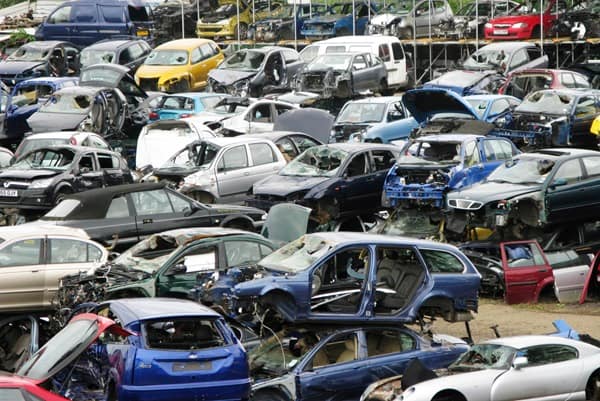Scrapping your car can be an effective way to contribute positively to the environment. When you choose to scrap your vehicle, at least 95% of it can be recycled, significantly reducing the need for new raw materials and decreasing carbon emissions. This process is not just about getting rid of an old car; it’s about participating in a sustainable practice that conserves resources and lowers energy consumption.
You’ll find that nearly every component of a scrapped car, from the metal body to plastic and tyres, can be repurposed. This reuse of parts helps to safeguard finite natural resources on our planet. By opting to scrap, you actively support a greener future while ensuring that your outdated vehicle doesn’t continue to emit more carbon into the atmosphere.
Take a moment to consider the environmental impact of your ageing car. Scrapping provides a straightforward option to mitigate this impact, ensuring that waste is minimised and resources are conserved. Through this approach, your decision to scrap becomes a meaningful step toward reducing environmental harm and enhancing ecological preservation.
The environmental benefits of scrapping your car
Scrapping your car is a beneficial process that has multiple environmental advantages. By ensuring that vehicles are dismantled and recycled, 95% of the car can often be reused. This acts to reduce waste significantly.
Recycling car parts means less material ends up in landfills. This helps to decrease landfill waste, contributing to a cleaner environment.
The process of scrapping diminishes carbon emissions. Fewer emissions from manufacturing new parts benefit climate change efforts, as recycling uses less energy.
Reusing materials and resources saves natural resources. Essential materials like steel, aluminium, and plastics can be recycled, diminishing the need to extract new raw materials.
You also contribute to water conservation by scrapping your car. The practice reduces water pollution by ensuring that hazardous substances present in vehicles are safely managed and disposed of.
Scrapping your vehicle can have economic benefits too. It supports job creation within recycling industries and fosters economic growth by bolstering sustainable practices.
By choosing to scrap your car, you actively participate in a cycle of sustainable resource management, promoting both environmental benefits and economic development.
The impact of end-of-life vehicles on the environment
End-of-life vehicles (ELVs) pose significant challenges to the environment due to the materials they contain. Hazardous materials like lead, mercury, and various fluids, such as engine oil and coolants, can leak and contaminate soil and waterways if not disposed of correctly.
Steel, aluminium, and rubber from tyres are abundant in ELVs. Proper recycling of these materials helps conserve natural resources and reduces the demand for new raw materials, which can be energy-intensive to produce.
The recycling process for ELVs is designed to minimise waste. An estimated 95% of a scrapped vehicle’s materials can be reused or recycled. This reduces the volume of waste sent to landfills and lessens the environmental burden.
Improperly managed ELVs can contribute to water pollution. The leakage of toxic substances can infiltrate water sources, affecting ecosystems and drinking water supplies.
Recycling end-of-life vehicles involves safe disposal of hazardous substances and efficient recovery of materials. This not only reduces pollution and conserves resources but also supports a circular economy by reintegrating these materials into new products.
You benefit from giving attention to the proper disposal processes of ELVs, aligning with sustainability goals while ensuring minimal environmental impact from ageing and obsolete vehicles.
How scrap car recycling reduces waste
When you choose to recycle your car, a significant amount of waste is diverted from landfills. Recycling ensures that parts and materials are reused effectively, keeping them in circulation rather than discarded.
Over 95% of a vehicle’s materials, including metals, plastics, and glass, can be recycled. Metals such as steel and aluminium are especially valuable as they can be melted down and repurposed. This reduces the need to extract new raw materials, thus conserving natural resources.
By using recycling facilities, you support waste management systems that specialise in the responsible handling of vehicle components. Parts like batteries, tyres, and fluids are processed to prevent environmental contamination.
Plastics found in vehicles can be recycled to create new products. This aids in cutting down the production of new plastics, which is often an energy-intensive process.
Incorporating car scrapping into your waste reduction strategy not only minimises landfill use but also promotes a circular economy. It transforms junk vehicles into valuable resources, reducing the strain on our planet’s natural reserves.
How car scrapping helps reduce carbon emissions
Scrapping your car significantly contributes to reducing carbon emissions by promoting recycling and ensuring proper disposal of materials. This process not only lowers the carbon footprint associated with vehicle production but also prevents harmful emissions from improper disposal methods.
The role of recycling in Lowering Carbon Footprints
When a car is scrapped, its materials are recycled, minimising the need for new raw materials. Recycling metals such as steel and aluminium cuts down on the energy required for extraction and processing. This energy saving translates to a reduction in carbon emissions. By repurposing these materials, you contribute to a decrease in the demand for mining and refining, both of which are energy-intensive activities.
With less new material needed, the carbon footprint from the lifecycle of vehicle production is reduced. Recycling also conserves natural resources and mitigates the pollutants released during the manufacturing process. Furthermore, the recycling of non-metal components like plastics can also lower emissions, although less significantly compared to metals.
How Proper Disposal Prevents Harmful Emissions
Proper disposal of car components is vital in preventing harmful emissions. Abandoned vehicles can release toxic chemicals into the environment, contributing to air and soil pollution. Parts like batteries and fluids such as oil, coolant, and petrol need careful handling to avoid leaching harmful substances.
By using authorised treatment facilities for scrapping, these hazardous materials are managed and disposed of responsibly. This process helps prevent emissions like volatile organic compounds (VOCs) that contribute to air pollution and climate change. Collecting and recycling these components reduce potential emissions, enhancing the environmental benefits of scrapping your car.
The recycling process: What happens to your car?
When you scrap your car, it undergoes a detailed recycling process. This involves breaking down its components for reuse and processing its scrap metal. Key elements like plastics, metals, and batteries are carefully managed to minimise environmental impacts.
Breaking down and reusing vehicle components
Once your car reaches the scrapyard, it is systematically dismantled. Components such as tyres, batteries, and fluids are removed first. Tyres may be repurposed for new uses or recycled into materials like rubber mulch.
Batteries are extracted to prevent environmental hazards; they are often recycled to recover lead and acid. Engine components and electronics are also recovered for future use or recycling. Seats and plastic elements might be processed into new products, reducing waste and conserving resources.
How scrap metal is processed and repurposed
Scrap metal is a significant part of vehicle recycling. Once non-metal parts are dealt with, the metal frame is crushed and shredded. Powerful magnets separate ferrous and non-ferrous metals for further processing.
Steel, the primary component, is melted down and repurposed for construction or manufacturing. Aluminium and copper are similarly recovered and recycled. This practice reduces the need for raw materials, saving energy and lowering emissions. Such metal recycling helps in creating a sustainable cycle of resource utilisation.
The role of Authorised Treatment Facilities (ATFs)
Authorised Treatment Facilities (ATFs) play a crucial role in ensuring that vehicles are disposed of in an environmentally friendly manner. They help reduce waste and minimise the environmental impact of old cars. By following strict environmental regulations, ATFs promote responsible vehicle disposal and recycling processes.
Why ATFs are essential for eco-friendly car scrapping
ATFs are instrumental in the eco-friendly scrapping of cars due to their adherence to stringent environmental regulations. These facilities are authorised to dismantle vehicles in a manner that prioritises recycling and reuse. By focusing on reducing waste, ATFs help decrease landfill use and conserve natural resources.
Vehicles processed at ATFs are dismantled with care to recover and recycle metals, plastics, and other materials. The facilities are equipped to handle the potentially hazardous components of vehicles safely, such as batteries and fluids, ensuring they don’t contaminate the environment. This responsible vehicle disposal reduces harmful emissions, contributing to a cleaner and healthier planet.
How to ensure your car is recycled responsibly
When recycling your vehicle, it’s crucial to choose an ATF to handle the process. An Authorised Treatment Facility is your best option for responsible vehicle recycling. They issue a Certificate of Destruction, which is vital for notifying the DVLA that your car has been properly disposed of. This ensures compliance with legal requirements and prevents any future liability.
To check if a facility is authorised, look for permits from relevant authorities, such as the Environment Agency. Selecting a reputable ATF guarantees that your car is dismantled ethically and environmentally, with recovered materials recycled efficiently. This step ensures that every part of your vehicle is handled in a way that benefits the environment.
How you can maximise the environmental impact when scrapping your car
Maximising the positive environmental impact when scrapping your car involves careful choices about where to take your vehicle and ensuring proper disposal of certain components.
Choosing the right scrap yard or service
Selecting a reputable scrap yard or online service like this one, it is crucial to maximising environmental benefits. Look for companies that adhere to vehicle scrappage policies and comply with environmental regulations. This ensures that the car recycling process is handled responsibly.
Check if the scrap yard is equipped to recycle at least 95% of the vehicle materials. Many modern facilities focus on sustainability and support the circular economy by reusing metals and parts, reducing the need for new raw materials.
Research reviews and certifications that highlight the yard’s environmental practices. Opt for services that prioritise eco-friendly methods and transparent operations. Some providers may offer pick-up services, which reduces emissions associated with transporting the vehicle.
Ensuring your car’s fluids and parts are disposed of properly
Proper disposal of your car’s fluids and parts is essential to avoid environmental harm. Before scrapping, ensure that fluids like oil, coolant, and brake fluid are drained and handled by professionals. These substances can contaminate soil and water if not managed correctly.
Components such as batteries, tyres, and electronic parts require specialised recycling processes. Batteries, for instance, contain hazardous materials that necessitate careful handling. Choose a service that follows correct disposal protocols for these items.
Confirm that the scrap yard recovers reusable parts to extend their lifecycle, contributing to waste reduction. This approach not only supports recycling efforts but also aligns with environmentally friendly practices, as it limits the disposal of potentially harmful materials in landfills.
Future trends in car recycling and sustainability
Emerging trends in car recycling focus on technological advancements and a shift towards sustainable practices in auto manufacturing. These developments contribute to a circular economy and help reduce the environmental impact.
Advancements in vehicle recycling technology
Technological progress plays a critical role in the efficiency of vehicle recycling. Enhanced shredding technologies enable the separation of materials like steel, aluminium, and plastics more effectively. This results in higher recovery rates of raw materials.
Automated dismantling processes have also been introduced, allowing for quicker and more precise extraction of reusable components such as batteries and electronic parts. Artificial intelligence and robotics are employed to streamline sorting and processing stages which minimises waste.
Additionally, advanced recycling methods are being explored to safely handle new materials used in electric vehicles. Understanding how to recycle these components is crucial as the number of electric cars on the road increases. Innovations in this area will support the sustainable growth of the automotive industry.
The shift toward more sustainable auto manufacturing
Manufacturers are increasingly prioritising sustainability from the outset. The design phase now considers the lifespan and recyclability of materials, ensuring that vehicles are easier to recycle at the end of their life. This approach forms a part of the broader circular economy strategy.
The adoption of eco-friendly materials, such as bioplastics and recycled metals, aims to minimise harmful environmental impacts. Automakers are also exploring sustainable energy sources for production processes, reducing overall carbon emissions.
Collaboration across the industry, including partnerships with recycling firms, supports these initiatives. By integrating recycling and sustainability into the entire manufacturing lifecycle, the auto industry is working towards a future where vehicle production and disposal are environmentally responsible.






Leave a Comment